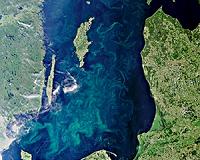 |
Blacksburg VA (SPX) Dec 10, 2010 When an antibiotic is consumed, researchers have learned that up to 90 percent passes through a body without metabolizing. This means the drugs can leave the body almost intact through normal bodily functions. In the case of agricultural areas, excreted antibiotics can then enter stream and river environments through a variety of ways, including discharges from animal feeding operations, fish hatcheries, and nonpoint sources such as the flow from fields where manure or biosolids have been applied. Water filtered through wastewater treatment plants may also contain used antibiotics. Consequently, these discharges become "potential sources of antibiotic resistance genes," says Amy Pruden, a National Science Foundation CAREER Award recipient, and an assistant professor of civil and environmental engineering at Virginia Tech. "The presence of antibiotics, even at sub-inhibitory concentrations, can stimulate bacterial metabolism and thus contribute to the selection and maintenance of antibiotic resistance genes," Pruden explains. "Once they are present in rivers, antibiotic resistance genes are capable of being transferred among bacteria, including pathogens, through horizontal gene transfer." The World Health Organization and the Center for Disease Control recognize antibiotic resistance "as a critical health challenge of our time," Pruden writes in a paper published in a 2010 issue of Environmental Science and Technology. Pruden says reducing the spread of antibiotic resistance is a critical measure needed to prolong the effectiveness of currently available antibiotics. This is important since "new drug discovery can no longer keep pace with emerging antibiotic-resistant infections," Pruden says. Pruden who has developed the concept of antibiotic resistance genes as environmental pollutants has an international reputation in applied microbial ecology, environmental remediation, and environmental reservoirs of antimicrobial resistance. In her work outlined in the Environmental Science and Technology article, she and her co-authors, H. Storteboom, M. Arabi and J.G. Davis, all of Colorado State University, and B. Crimi of Delft University in The Netherlands, identified specific patterns of antibiotic resistance gene occurrence in a Colorado watershed. Identification of these patterns represents a major step in being able to discriminate between agricultural and wastewater treatment plant sources of these genes in river environments. They assert that such unique patterns of antibiotic resistance gene occurrence represent promising molecular signatures that may then be used as tracers of specific manmade sources. In their study they identified three wastewater treatment plant sites, six animal feeding operation locations, and three additional locations along a pristine region of the Poudre River, in an upstream section located in the Rocky Mountains. They compared the frequency of detection of 11 sulfonamide and tetracycline antibiotic resistance genes. Their findings showed detection of one particular antibiotic resistance gene in 100 percent of the treatment plant and animal feeding operations, but only once in the clean section of the Poudre River. As they are able to differentiate between human and animal sources of the antibiotic resistance genes, Pruden and her colleagues believe they can "shed light on areas where intervention can be most effective in helping to reduce the spread of these contaminants through environmental matrixes such as soils, groundwater, surface water and sediments. "This study advances the recognition of antibiotic resistance genes as sources to impacted environments, taking an important step in the identification of the dominant processes of the spreading and transport of antibiotic resistance genes."
Share This Article With Planet Earth
Related Links Virginia Tech Our Polluted World and Cleaning It Up
 Eutrophication Makes Toxic Cyanobacteria More Toxic
Eutrophication Makes Toxic Cyanobacteria More ToxicGothenburg, Sweden (SPX) Dec 09, 2010 Continued eutrophication of the Baltic Sea, combined with an ever thinner ozone layer, is favouring the toxic cyanobacterium Nodularia spumigena, reveals research from the University of Gothenburg, Sweden. "There are several species of cyanobacteria, or blue-green algae, that can form surface blooms in the Baltic Sea," explains Malin Mohlin from the University of Gothenburg's Department of ... read more |
|
| The content herein, unless otherwise known to be public domain, are Copyright 1995-2010 - SpaceDaily. AFP and UPI Wire Stories are copyright Agence France-Presse and United Press International. ESA Portal Reports are copyright European Space Agency. All NASA sourced material is public domain. Additional copyrights may apply in whole or part to other bona fide parties. Advertising does not imply endorsement,agreement or approval of any opinions, statements or information provided by SpaceDaily on any Web page published or hosted by SpaceDaily. Privacy Statement |